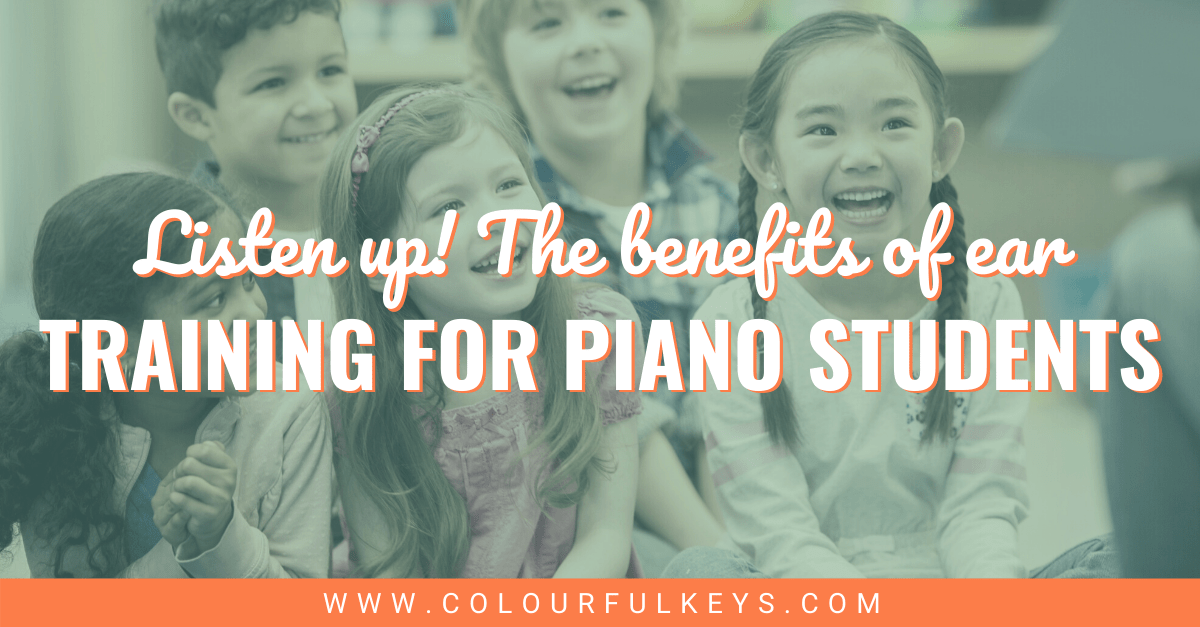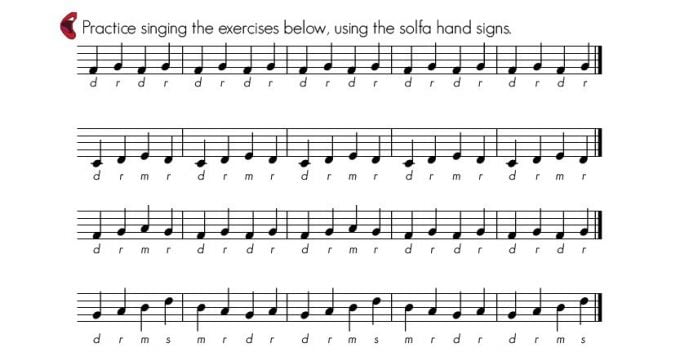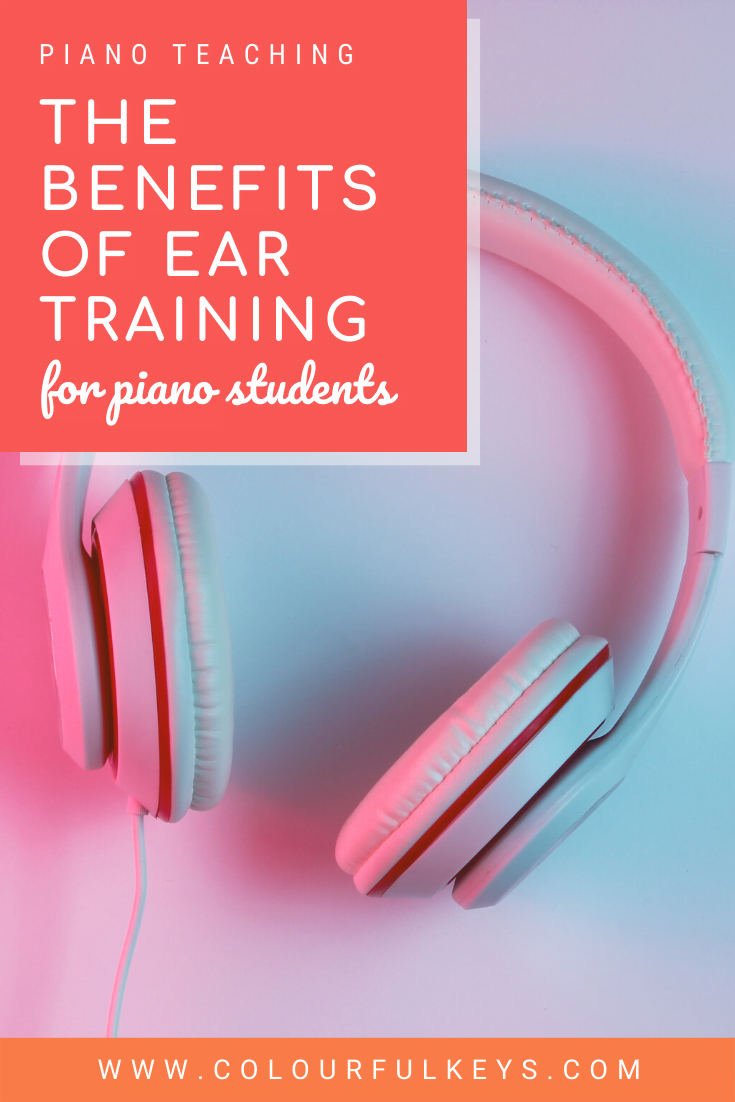This post about the benefits of ear training for piano students was written in May 2016 and updated in March 2021.
Listening should be a big part of all music lessons…I mean of course it should, right? We are teaching music after all – which is, in essence, a particular type of sound.
Yet, when I was learning piano, and when I first started teaching, the importance was placed on reading music. Piano students were supposed to learn to read pieces first, and then somehow transform them into music later.

That is also how a lot of method books are set up: They follow what they see as the most logical progression of reading skills, sacrificing melody and harmony along the way.
Why did I spend so much time discouraging students from using their ears?
This certainly is not what I intended to do, but it did happen. From the start, I was focussed on creating good readers. First and foremost, all my strategies emphasised reading – with everything else coming in second place. That is, until I realised what I was doing and why I was doing it.
Let’s look at some of the ways I used to discourage listening, and how how I’ve flipped it to start actively teaching listening once I saw the benefits of ear training for piano students.
Aural Skills Tests in Piano Lessons
Some form of aural skills tests are part of almost every exam system. Much like the sight reading tests in exams, these are short, compartmentalised versions of real-world listening skills.

I’m not criticising them – I’m glad there is a listening portion of practical exams. I’m just not happy that these are the only aural skills taught in most piano lessons here in Ireland. Piano students are missing out on all the wonderful benefits of ear training.
Then
In my own piano education, these tests were practiced a few weeks before the exam. I don’t remember even receiving much advice on how to listen for the answers, just the tests being drilled until I got it right. Everything in my training was telling me that listening comes last.
Now
Ahem…we’re teaching music making, right???
From the start, I now teach listening skills as an integrated part of lessons. My littlest students could be listening for loud sounds vs soft sounds, or clapping the beat with a jump on the first beat of the bar. Teenagers might be improvising over an accompaniment which continually changes metre, and having to guess the new time signature as we play.
Repertoire
Then
For the first 7 or so years of my piano teaching, I almost never played for my students. I played their exam pieces so they could choose selections, and occasionally demonstrated small sections – but not often.
I was so concerned with making sure my students could read independently that I forgot to inspire them, or to help them be musical.
Now
These days, however, I regularly play for my students. And they don’t just listen to my own playing: My students are quite used to seeing listening assignments on their assignment sheets.
I recently had a very dedicated, musical, and academically-strong 12-year-old student who was about to take her grade 5 piano exam. She had been working on a 40 Piece Challenge that year and learning music at a wide variety of levels.
As we moved towards the exam, though, I didn’t want to give her more challenging repertoire because I knew it would just get ignored in favour of exam work.
So to transition her into a piece we would be working on once the exam was over, I decided to give her a listening assignment. All she had to do is listen to the piece while following along with the score. That’s it. Easiest assignment ever, right?!
The next week at her lesson she asked me a very serious question:
“I just want to know” she said,
“How this piece can be soooo beautiful?”

She started playing little sections of the score to demonstrate to me this unfathomable beauty.
True, she definitely didn’t have to work as hard to read that piece, as she was able to “fall back” on her ear much more. But wasn’t the tradeoff completely worth it? She was so excited to learn this piece after her exam was over, because she was already completely in love with it.
Singing
Do you sing in your piano lessons? Singing is a great way to incorporate ear training into your lessons, and allows piano students to experience first-hand the benefits of solid aural skills.
Then
I don’t remember my first two piano teachers singing at all. Not one bit.
Somehow though, I was supposed to be able to sight sing a melody in my exams. I dreaded this part of my exams. I felt like I was just supposed to intuitively know how to do it, and the fact that I couldn’t was just a lack of talent on my part.
What complete and utter nonsense I eventually realised this to be! We don’t magically know – or not know – how to sing at sight. It can be and should be taught.
Now
I teach sight singing using solfa (with moveable do). For my students who take exams, those sight singing marks are a gimme – not a hard part.
Singing shouldn’t just be for sight singing exercises though. I sing all the time in my piano lessons.
Don’t get me wrong: I am not a singer. Not at all! But if I want my students to do something, I’d better show them I’m willing to do it myself. 😁
Simply singing along improves students’ phrasing, dynamics, rhythm and articulation, among many more things.
For instance, if a student can’t get the hang of a slur into a staccato note, I’ll try singing along with a “Dooo-da!” Often this is enough to fix the problem – no long winded explanations or analogies needed. Having ways to verbalise articulations can really aid memory and make at-home practice more effective, too.
Singing can play a major role in reading, too – especially sight reading. When I teach sight reading, I often have my students sing through the melody first. Even if their pitch isn’t remotely accurate, the mere act of singing is valuable as it helps students think through the melodic shape and the intervals.
If I’ve convinced you to include ear training in your lessons but you’re not sure how, never fear! I’ve got you covered here. 😉
Do aural skills play an important part in your piano lessons?
What other benefits have you discovered from teaching ear training? Share your thoughts in the comments below or in the Vibrant Music Studio Teachers Facebook group.

